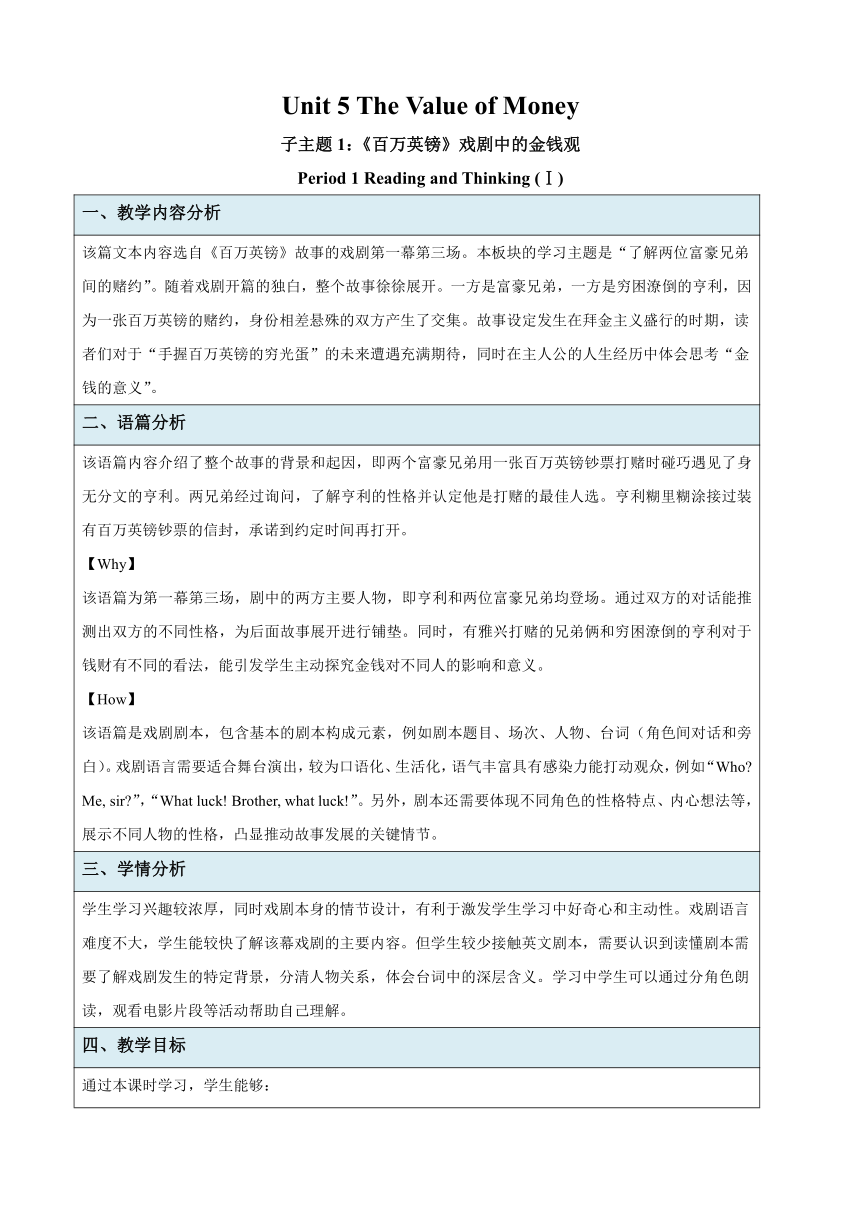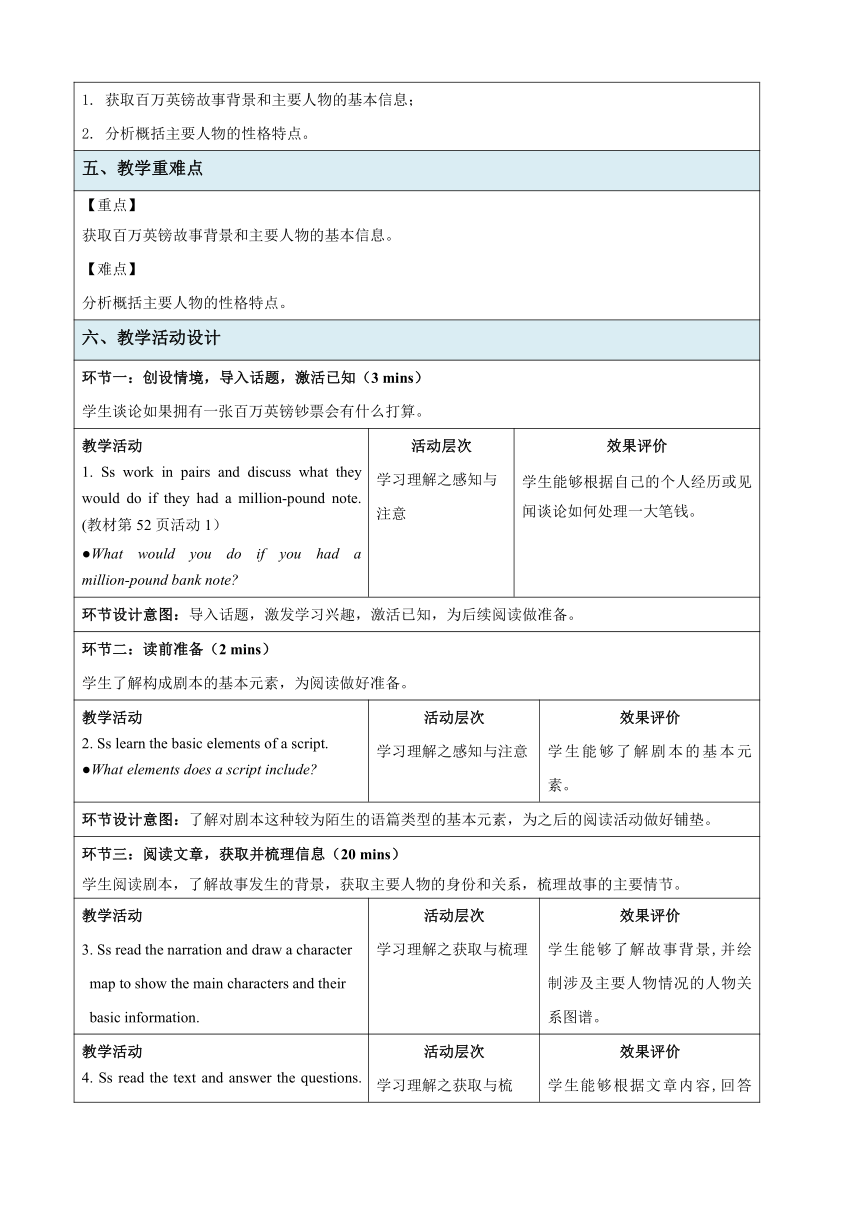人教版(2019)必修第三册Unit 5 The Value of Money Reading and Thinking 教学设计(表格式)
文档属性
| 名称 | 人教版(2019)必修第三册Unit 5 The Value of Money Reading and Thinking 教学设计(表格式) |  | |
| 格式 | docx | ||
| 文件大小 | 27.8KB | ||
| 资源类型 | 教案 | ||
| 版本资源 | 人教版(2019) | ||
| 科目 | 英语 | ||
| 更新时间 | 2024-05-04 09:13:23 | ||
图片预览


文档简介
Unit 5 The Value of Money
子主题1:《百万英镑》戏剧中的金钱观
Period 1 Reading and Thinking (Ⅰ)
一、教学内容分析
该篇文本内容选自《百万英镑》故事的戏剧第一幕第三场。本板块的学习主题是“了解两位富豪兄弟间的赌约”。随着戏剧开篇的独白,整个故事徐徐展开。一方是富豪兄弟,一方是穷困潦倒的亨利,因为一张百万英镑的赌约,身份相差悬殊的双方产生了交集。故事设定发生在拜金主义盛行的时期,读者们对于“手握百万英镑的穷光蛋”的未来遭遇充满期待,同时在主人公的人生经历中体会思考“金钱的意义”。
二、语篇分析
该语篇内容介绍了整个故事的背景和起因,即两个富豪兄弟用一张百万英镑钞票打赌时碰巧遇见了身无分文的亨利。两兄弟经过询问,了解亨利的性格并认定他是打赌的最佳人选。亨利糊里糊涂接过装有百万英镑钞票的信封,承诺到约定时间再打开。 【Why】 该语篇为第一幕第三场,剧中的两方主要人物,即亨利和两位富豪兄弟均登场。通过双方的对话能推测出双方的不同性格,为后面故事展开进行铺垫。同时,有雅兴打赌的兄弟俩和穷困潦倒的亨利对于钱财有不同的看法,能引发学生主动探究金钱对不同人的影响和意义。 【How】 该语篇是戏剧剧本,包含基本的剧本构成元素,例如剧本题目、场次、人物、台词(角色间对话和旁白)。戏剧语言需要适合舞台演出,较为口语化、生活化,语气丰富具有感染力能打动观众,例如“Who Me, sir ”,“What luck! Brother, what luck!”。另外,剧本还需要体现不同角色的性格特点、内心想法等,展示不同人物的性格,凸显推动故事发展的关键情节。
三、学情分析
学生学习兴趣较浓厚,同时戏剧本身的情节设计,有利于激发学生学习中好奇心和主动性。戏剧语言难度不大,学生能较快了解该幕戏剧的主要内容。但学生较少接触英文剧本,需要认识到读懂剧本需要了解戏剧发生的特定背景,分清人物关系,体会台词中的深层含义。学习中学生可以通过分角色朗读,观看电影片段等活动帮助自己理解。
四、教学目标
通过本课时学习,学生能够: 1. 获取百万英镑故事背景和主要人物的基本信息; 2. 分析概括主要人物的性格特点。
五、教学重难点
【重点】 获取百万英镑故事背景和主要人物的基本信息。 【难点】 分析概括主要人物的性格特点。
六、教学活动设计
环节一:创设情境,导入话题,激活已知(3 mins) 学生谈论如果拥有一张百万英镑钞票会有什么打算。
教学活动 1. Ss work in pairs and discuss what they would do if they had a million-pound note. (教材第52页活动1) ●What would you do if you had a million-pound bank note 活动层次 学习理解之感知与注意 效果评价 学生能够根据自己的个人经历或见闻谈论如何处理一大笔钱。
环节设计意图:导入话题,激发学习兴趣,激活已知,为后续阅读做准备。
环节二:读前准备(2 mins) 学生了解构成剧本的基本元素,为阅读做好准备。
教学活动 2. Ss learn the basic elements of a script. ●What elements does a script include 活动层次 学习理解之感知与注意 效果评价 学生能够了解剧本的基本元素。
环节设计意图:了解对剧本这种较为陌生的语篇类型的基本元素,为之后的阅读活动做好铺垫。
环节三:阅读文章,获取并梳理信息(20 mins) 学生阅读剧本,了解故事发生的背景,获取主要人物的身份和关系,梳理故事的主要情节。
教学活动 3. Ss read the narration and draw a character map to show the main characters and their basic information. 活动层次 学习理解之获取与梳理 效果评价 学生能够了解故事背景,并绘制涉及主要人物情况的人物关系图谱。
教学活动 4. Ss read the text and answer the questions. (教材第52页活动2) 活动层次 学习理解之获取与梳理,概括与整合 效果评价 学生能够根据文章内容,回答相关问题。
教学活动 5. Ss retell the passage with the help of the character map and their answers. 活动层次 学习理解之概括与整合 效果评价 学生能够借助人物关系图谱和阅读,给出问题的答案, 简单介绍这场戏剧的主要内容。
环节设计意图: 引导学生基于阅读的基本信息,理清故事的主要情节。
环节四:深入阅读,学习语言,理解戏剧台词的隐含意思(12 mins) 学生再次阅读剧本,根据主人公的生动对话,分析人物的心理活动和情感,并充分理解人物的“潜台词”,及他们真实的愿望或意图。
教学活动 6. Ss read the sentences and describe Henry’s feelings using suitable adjectives. (教材第53页活动3) 活动层次 应用实践之分析与判断,描述与阐释 效果评价 学生能够通过阅读和讨论,理解主人公Henry在故事发展中的情绪变化。
教学活动 7. Ss work in pairs and explain what the speakers mean by saying these sentences. (教材第53页活动4) 活动层次 应用实践之分析与判断,描述与阐释 效果评价 学生能够通过阅读和讨论,结合剧中人物的身份、处境等推测理解台词中的隐含信息。
环节设计意图: 学生在语境中体会台词,准确理解字里行间的隐含意思,充分内化语言并对本场戏剧的情节有更深入的理解。
环节五:根据剧本和本节课所学知识,表演本场戏剧(8 mins) 学生听录音,进一步揣摩、设计人物的语气、神态、动作等,表演本场戏剧。
教学活动 8. Ss listen to the record and pay attention to the tricks in pronunciation, such as a high or low tone, and rising or falling intonation. Then Ss role-play Act 1, Scene 3 with their partners 活动层次 学习理解之获取与梳理 应用实践之内化与应用 迁移创新之想象与创造 效果评价 学生能够通过听课文音频,进一步熟悉剧本内容,关注关键情节时人物的语气、语调,最后演出本场戏剧。
环节设计意图: 学生充分理解剧本内容后,在分析主要人物的情感和性格,进一步揣摩人物的语气、神态、肢体语言等,体现情感与文化内涵。
作业与拓展学习设计 Video your performance, paying special attention to the tones, intonations and their implied meanings.
Worksheet
Unit 5 Reading and Thinking (Ⅰ)
Activity 1: Discuss and share
Work in pairs and discuss the following question:
What would you do if you had a million-pound bank note
Activity 2: Discuss in groups
Brainstorm the basic elements of a script.
What elements does a script include
Activity 3: Read and draw a character map
Read the narration and draw a character map to show the main characters and their basic information.
Activity 4: Read and answer
Read the text and answer the questions.
Activity 5: Retell
Retell the passage with the help of the character map and your answers. Use Evaluation Form 1 to evaluate your classmates’ retelling.
Item Peer-evaluation Teacher-evaluation
Content: ﹡the main characters and their basic information ﹡the development of the story ☆☆☆☆☆ ☆☆☆☆☆
Language accuracy ☆☆☆☆☆ ☆☆☆☆☆
Fluency and pronunciation ☆☆☆☆☆ ☆☆☆☆☆
Logic and coherence ☆☆☆☆☆ ☆☆☆☆☆
Activity 6: Read and answer
Read the sentences and describe Henry’s feelings using suitable adjectives. (教材第53页活动3)
Activity 7: Read and explain
Work in pairs and explain what the speakers mean by saying these sentences. (教材第53页活动4)
Activity 8: Listen and act
Listen to the recording and pay attention to the tricks in pronunciation, such as a high or low tone, and rising or falling intonation. Then role-play Act 1, Scene 3 with their partners. Use Evaluation Form 2 to evaluate each other’s performance.
Item Peer-evaluation Teacher-evaluation
Content: ﹡the main characters ﹡the development of the story ☆☆☆☆☆ ☆☆☆☆☆
Language accuracy ☆☆☆☆☆ ☆☆☆☆☆
Fluency and pronunciation ☆☆☆☆☆ ☆☆☆☆☆
Facial expression and body language ☆☆☆☆☆ ☆☆☆☆☆
Logic and coherence ☆☆☆☆☆ ☆☆☆☆☆
Homework:
Video your performance, paying special attention to the tones, intonations and their implied meanings.
子主题1:《百万英镑》戏剧中的金钱观
Period 1 Reading and Thinking (Ⅰ)
一、教学内容分析
该篇文本内容选自《百万英镑》故事的戏剧第一幕第三场。本板块的学习主题是“了解两位富豪兄弟间的赌约”。随着戏剧开篇的独白,整个故事徐徐展开。一方是富豪兄弟,一方是穷困潦倒的亨利,因为一张百万英镑的赌约,身份相差悬殊的双方产生了交集。故事设定发生在拜金主义盛行的时期,读者们对于“手握百万英镑的穷光蛋”的未来遭遇充满期待,同时在主人公的人生经历中体会思考“金钱的意义”。
二、语篇分析
该语篇内容介绍了整个故事的背景和起因,即两个富豪兄弟用一张百万英镑钞票打赌时碰巧遇见了身无分文的亨利。两兄弟经过询问,了解亨利的性格并认定他是打赌的最佳人选。亨利糊里糊涂接过装有百万英镑钞票的信封,承诺到约定时间再打开。 【Why】 该语篇为第一幕第三场,剧中的两方主要人物,即亨利和两位富豪兄弟均登场。通过双方的对话能推测出双方的不同性格,为后面故事展开进行铺垫。同时,有雅兴打赌的兄弟俩和穷困潦倒的亨利对于钱财有不同的看法,能引发学生主动探究金钱对不同人的影响和意义。 【How】 该语篇是戏剧剧本,包含基本的剧本构成元素,例如剧本题目、场次、人物、台词(角色间对话和旁白)。戏剧语言需要适合舞台演出,较为口语化、生活化,语气丰富具有感染力能打动观众,例如“Who Me, sir ”,“What luck! Brother, what luck!”。另外,剧本还需要体现不同角色的性格特点、内心想法等,展示不同人物的性格,凸显推动故事发展的关键情节。
三、学情分析
学生学习兴趣较浓厚,同时戏剧本身的情节设计,有利于激发学生学习中好奇心和主动性。戏剧语言难度不大,学生能较快了解该幕戏剧的主要内容。但学生较少接触英文剧本,需要认识到读懂剧本需要了解戏剧发生的特定背景,分清人物关系,体会台词中的深层含义。学习中学生可以通过分角色朗读,观看电影片段等活动帮助自己理解。
四、教学目标
通过本课时学习,学生能够: 1. 获取百万英镑故事背景和主要人物的基本信息; 2. 分析概括主要人物的性格特点。
五、教学重难点
【重点】 获取百万英镑故事背景和主要人物的基本信息。 【难点】 分析概括主要人物的性格特点。
六、教学活动设计
环节一:创设情境,导入话题,激活已知(3 mins) 学生谈论如果拥有一张百万英镑钞票会有什么打算。
教学活动 1. Ss work in pairs and discuss what they would do if they had a million-pound note. (教材第52页活动1) ●What would you do if you had a million-pound bank note 活动层次 学习理解之感知与注意 效果评价 学生能够根据自己的个人经历或见闻谈论如何处理一大笔钱。
环节设计意图:导入话题,激发学习兴趣,激活已知,为后续阅读做准备。
环节二:读前准备(2 mins) 学生了解构成剧本的基本元素,为阅读做好准备。
教学活动 2. Ss learn the basic elements of a script. ●What elements does a script include 活动层次 学习理解之感知与注意 效果评价 学生能够了解剧本的基本元素。
环节设计意图:了解对剧本这种较为陌生的语篇类型的基本元素,为之后的阅读活动做好铺垫。
环节三:阅读文章,获取并梳理信息(20 mins) 学生阅读剧本,了解故事发生的背景,获取主要人物的身份和关系,梳理故事的主要情节。
教学活动 3. Ss read the narration and draw a character map to show the main characters and their basic information. 活动层次 学习理解之获取与梳理 效果评价 学生能够了解故事背景,并绘制涉及主要人物情况的人物关系图谱。
教学活动 4. Ss read the text and answer the questions. (教材第52页活动2) 活动层次 学习理解之获取与梳理,概括与整合 效果评价 学生能够根据文章内容,回答相关问题。
教学活动 5. Ss retell the passage with the help of the character map and their answers. 活动层次 学习理解之概括与整合 效果评价 学生能够借助人物关系图谱和阅读,给出问题的答案, 简单介绍这场戏剧的主要内容。
环节设计意图: 引导学生基于阅读的基本信息,理清故事的主要情节。
环节四:深入阅读,学习语言,理解戏剧台词的隐含意思(12 mins) 学生再次阅读剧本,根据主人公的生动对话,分析人物的心理活动和情感,并充分理解人物的“潜台词”,及他们真实的愿望或意图。
教学活动 6. Ss read the sentences and describe Henry’s feelings using suitable adjectives. (教材第53页活动3) 活动层次 应用实践之分析与判断,描述与阐释 效果评价 学生能够通过阅读和讨论,理解主人公Henry在故事发展中的情绪变化。
教学活动 7. Ss work in pairs and explain what the speakers mean by saying these sentences. (教材第53页活动4) 活动层次 应用实践之分析与判断,描述与阐释 效果评价 学生能够通过阅读和讨论,结合剧中人物的身份、处境等推测理解台词中的隐含信息。
环节设计意图: 学生在语境中体会台词,准确理解字里行间的隐含意思,充分内化语言并对本场戏剧的情节有更深入的理解。
环节五:根据剧本和本节课所学知识,表演本场戏剧(8 mins) 学生听录音,进一步揣摩、设计人物的语气、神态、动作等,表演本场戏剧。
教学活动 8. Ss listen to the record and pay attention to the tricks in pronunciation, such as a high or low tone, and rising or falling intonation. Then Ss role-play Act 1, Scene 3 with their partners 活动层次 学习理解之获取与梳理 应用实践之内化与应用 迁移创新之想象与创造 效果评价 学生能够通过听课文音频,进一步熟悉剧本内容,关注关键情节时人物的语气、语调,最后演出本场戏剧。
环节设计意图: 学生充分理解剧本内容后,在分析主要人物的情感和性格,进一步揣摩人物的语气、神态、肢体语言等,体现情感与文化内涵。
作业与拓展学习设计 Video your performance, paying special attention to the tones, intonations and their implied meanings.
Worksheet
Unit 5 Reading and Thinking (Ⅰ)
Activity 1: Discuss and share
Work in pairs and discuss the following question:
What would you do if you had a million-pound bank note
Activity 2: Discuss in groups
Brainstorm the basic elements of a script.
What elements does a script include
Activity 3: Read and draw a character map
Read the narration and draw a character map to show the main characters and their basic information.
Activity 4: Read and answer
Read the text and answer the questions.
Activity 5: Retell
Retell the passage with the help of the character map and your answers. Use Evaluation Form 1 to evaluate your classmates’ retelling.
Item Peer-evaluation Teacher-evaluation
Content: ﹡the main characters and their basic information ﹡the development of the story ☆☆☆☆☆ ☆☆☆☆☆
Language accuracy ☆☆☆☆☆ ☆☆☆☆☆
Fluency and pronunciation ☆☆☆☆☆ ☆☆☆☆☆
Logic and coherence ☆☆☆☆☆ ☆☆☆☆☆
Activity 6: Read and answer
Read the sentences and describe Henry’s feelings using suitable adjectives. (教材第53页活动3)
Activity 7: Read and explain
Work in pairs and explain what the speakers mean by saying these sentences. (教材第53页活动4)
Activity 8: Listen and act
Listen to the recording and pay attention to the tricks in pronunciation, such as a high or low tone, and rising or falling intonation. Then role-play Act 1, Scene 3 with their partners. Use Evaluation Form 2 to evaluate each other’s performance.
Item Peer-evaluation Teacher-evaluation
Content: ﹡the main characters ﹡the development of the story ☆☆☆☆☆ ☆☆☆☆☆
Language accuracy ☆☆☆☆☆ ☆☆☆☆☆
Fluency and pronunciation ☆☆☆☆☆ ☆☆☆☆☆
Facial expression and body language ☆☆☆☆☆ ☆☆☆☆☆
Logic and coherence ☆☆☆☆☆ ☆☆☆☆☆
Homework:
Video your performance, paying special attention to the tones, intonations and their implied meanings.
